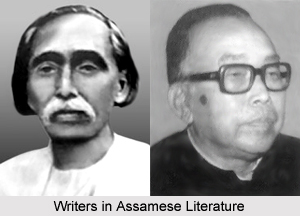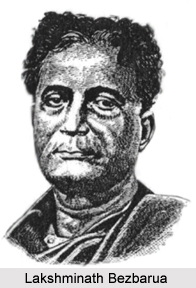 Influence of West on Assamese fictions had been a noteworthy phenomenon that changed the course of history and Assamese literature forever. Literature of one language does cast its influence on another language is a universal discourse. What confirms in the total process of absolute metamorphosis is the change in matter, form outlook. The socio-cultural differences mark the fusion of these two languages marked by the geographical proximity. A new language flourishes which is betrothed as well as amalgamated India as for example India having a common cultural and religious heritage. Morden Indian literature, more specifically Assamese Literature has come under the influence of foreign literatures.
Influence of West on Assamese fictions had been a noteworthy phenomenon that changed the course of history and Assamese literature forever. Literature of one language does cast its influence on another language is a universal discourse. What confirms in the total process of absolute metamorphosis is the change in matter, form outlook. The socio-cultural differences mark the fusion of these two languages marked by the geographical proximity. A new language flourishes which is betrothed as well as amalgamated India as for example India having a common cultural and religious heritage. Morden Indian literature, more specifically Assamese Literature has come under the influence of foreign literatures.
History of Influence of West on Assamese Fictions
The novel in Assamese came in the wake of the western system of education that was introduced by the British Administration, and it drew its inspiration from the literature of the west. In the pages of the Arunoday itself, an Assamese rendering of Bunyan`s Pilgrim`s Progress began to appear in serial under the caption, Yatrikarar Yatra. In 1880 appeared Sudharmar Upakhyan of Padmavati Devi Phukanani, which got some publicity as the first novel by an Assamese lady, and which is not without some intrinsic merit. But the first attempt at anything approaching a plot, was Hem Chandra Barua`s Bahire rang-cang Bhitare Kowa Bhaturi (Playing in the parlour, empty is the larder). As this is a novel with a purpose directed against the social and religious evils of the time, here for the first time realism and characterisation find fuller development. After the social novel, the historical novel was taken up, and` in this genre Lakshminath Bezbarua was a leading writer.
Influence of West on Earlier Assamese Fictions
New forms like the short story, novel and essay had been introduced under Western inspiration. Technically, the short story is different from existing folk-tales. The modern short story has developed technically and subject matter along with variety and vision. Beginning with L. N. Bezbaroa (1868-1938) and Sarat Goswami (1884-1944), the short story has established itself in variety and potentiality of technique and subject-matter. Lakshminath Bezbarua`s novel Padum Kunwari is a story of tragic love. Padmanath Gohain Barua wrote two novels, Lahari and Bhanumati, both centring round love. Both have the background of the Ahom days. The short story is the chief literary type that grew in recent times under the influence of the west. There have been stories, tales, myths, fables, parables and anecdotes in Assamese from very old times. But these differ from the modern short story profoundly in both matter and technique.
 Assamese Modern Fiction under the Influence of West
Assamese Modern Fiction under the Influence of West
The output of fiction in Assamese is, however, limited, and did not reach maturity till the last decade. In recent years the standard has gone up and several new and salutary tendencies are discernible. From the old romantic sagas, they have now gone to realistic and psycho-analytic themes. The present day fiction writers have turned their eyes on those who are neglected by society, and try to assess their unique social value. One of such novels, on the rural life of Assam, is Jivanar Batat (On the Highway of Life) by Bina Barua (pseudonym of Birinchi Kumar Barua). In another novel, Seuji Patar Kahini (Story of Green Leaves) the author portrays the life and society of teagarden labourers with sympathy. Dinanath Sarma`s Nadai is also a novel on village life. Hitesh Deka`s Ajir Manuh (The Man of the Age) and Mati Kar (Who owns the land ?) deal with present day life and agrarian problems, and an attempt is made to evaluate the political and social rights of man. His Bhara Ghar describes a love story round the ever-growing urban housing problem. Adyanath Sarma`s Jivanar Tini Adhyay (Three Chapters of Life), Chandrakanta Gogoi`s Sonar Nangal (The Golden Plough), Govinda Mahanta`s Krsakar Nati (The Cultivator`s Descendants) are some of the outstanding novels of social study.
Woven round a love story, Navakanta Barua`s Kapilipariya Sadhu depicts the unfortunate tale of the people dwelling on the bank of the river Kapili, which changes its course whimsically every year. In Da var aru Nai (Clouds No More). Jogesh Das portrays the disruptive effects of the last World War upon the ethics and manners of our society. Muhammed Piar mostly writes of town life. Some psychological novels produced during recent years have made a mark by their realistic technique, depiction of the subconscious motives and urges of the human heart, men and women being seen as jets of emotional energy drawn from the vast, dark tides of unconscious impulse. Praphulladatta Goswami`s Keca Patar Kapani (The Quivering Foliage) describes the ideological unrest of a young man who makes a mess of his own life longing for better things and seeking peace in beauty. Goswami`s genius is essentially aesthetic and visionary. Radhikamohan Goswami`s Caknaiya (The Vortex) portrays the life of a frustrated young man who cannot adapt himself to the present-day society. Birendrakumar Bhattacharya, in his Rajpathe Ringiyai (The Call of the Highway), depicts the life of a young revolutionary who wants to set right the `wrongs` of society. The entire approach of the author is political and the treatment psychological.
In Chabi Ghar (The Picture House), Malik covers psycho-analysis and social consciousness again backed by the influence from west. Unfortunately the story is lost in the experiment. Surujmukhir svana is Malik`s latest and successful creation. The thriller or detective fiction is new to Assamese literature influenced by the European trends of Freudian flows. The late growth is due to historical reasons. Assam did not have big towns or cities till the other day. Now along with the growth of big towns and development of trade and commerce, emigration to towns and business centres has led to various crimes which are reported in the daily newspapers. These, therefore, provide themes for thrillers. Premanarayan Datta`s Pa-Phu series is well known. Most of the detective novels have, however, neither much inventive faculty nor skill to render the incredible credible; as a result, improbabilities remain wildly improbable.
Sarat Chandra Goswami achieved considerable success as a writer of short stories, and the collected editions of his short stories, Galpanjali and Mayna, contain powerfully conceived stories happy alike for skilful and conscientious tious craftsmanship, for building up of atmosphere, and for characterisation. In Banariya Pranaya (Wild Love) in the Mayna collection is described the romantic love of a Miri youth and maiden, whose union is disapproved by their parents. Several other stories deal with illicit love, but nowhere is there any lapse into unrefined taste or feeling, nor is there any unnaturalness anywhere. Yatri (The Traveller) is another story dealing with illegitimate love. Godadhar nearly succumbs to the charms of Santi; but the fear of social ostracism proves a powerful deterrent. He flees from her and saves himself. In Brahmaputrar Bukat (Into the Bosom of the Brahmaputra) a married woman, who had a secret love-affair with a second man, ends her distressed life by jumping into the river Brahmaputra. In more stories than one, Goswami has drawn vivid pictures of the pathetic life of girl-widows. Free from bias and sophistication, sensitive and profoundly realistic, Goswami records his observation of human nature and frailty with the most sober sincerity.



















